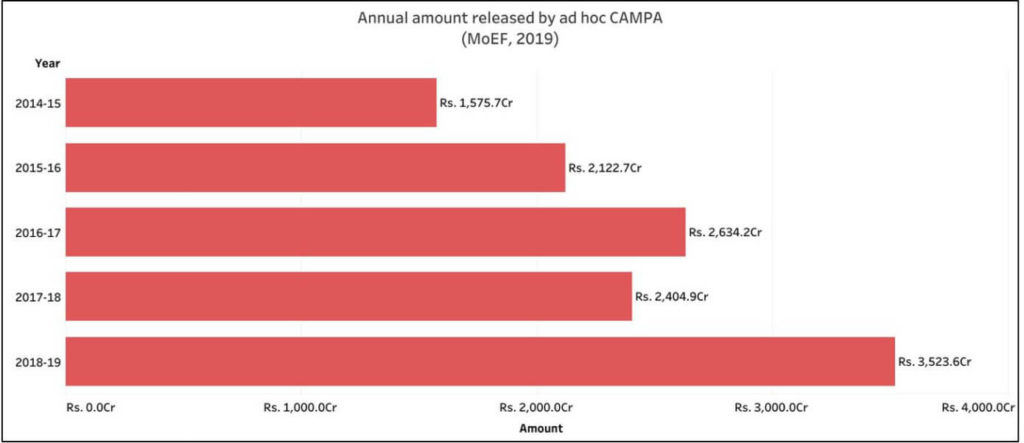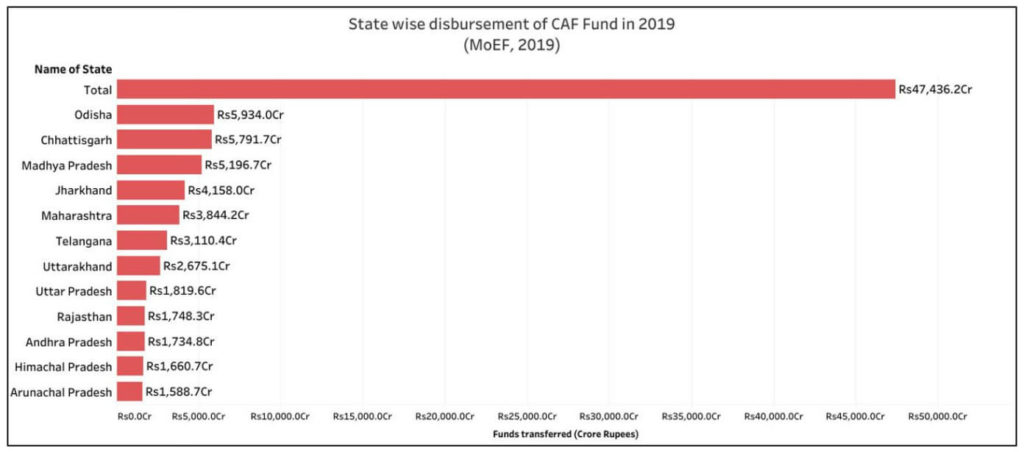Recently, the central government released more than ₹ 47000 crores CAMPA funds to the States. But what are CAMPA funds? Here is an explainer.
In India, Forest land can be diverted for non-forest purposes such as construction of dams, mining and other developmental activities only if the government permits. Since this diversion of forest land results in loss of biodiversity which in turn affects wildlife as well as geographical parameters such as climate and terrain, compensatory afforestation is also mandated in the law. In other words, to compensate for the losses incurred, the government made compensatory afforestation mandatory. This story takes a look at the measures taken by the government to ensure the same and the status of Compensatory Afforestation Fund Management and Planning Authority (CAMPA) funds.
Compensatory afforestation is mandatory in case of diversion of Forest Land
Whenever forest land is diverted for non-forest purposes, it is mandatory under the Forest (Conservation) Act, 1980 that an equivalent area of non-forest land has to be taken up for compensatory afforestation. In addition to this, funds for raising the forest are also to be imposed on whomsoever is undertaking the diversion. The land chosen for afforestation, if viable, must be in close proximity of reserved or protected forest for ease of management by forest department.
An undertaking to pay for CA activities is also mandatory for clearance
At the time of
submission of project proposal to apply for forest clearance,
the applicant must attach an undertaking stating that they will bear the cost
of compensatory afforestation as per existing rules & scheme.

The forest department must also provide details regarding the area identified for afforestation. It is only after this, that the proposal goes to higher authorities for recommendations and approval.
SC in 2002 directed that CA fund be created
In 2002, the Supreme Court (SC) ordered that a Compensatory Afforestation Fund had to be created in which all the contributions towards compensatory afforestation and net present value of land had to be deposited. This order was made in the case of TN Godhavarman Vs Union of India where the SC observed that a lot of funds received for compensatory afforestation remained unutilised with the states.
CAMPA was constituted in 2004 by MoEF to manage CAF
In April 2004, Ministry of Environment and Forests constituted Compensatory Afforestation Fund Management and Planning Authority (CAMPA) to overlook and manage the Compensatory Afforestation Fund (CAF) as directed by the SC. The authority was termed as the ‘custodian’ of the fund. Further in 2009, the government ordered that State CAMPAs had to be set up to boost compensatory afforestation at state level and also manage Green India Fund.
CAG report showed that utilisation of fund under CAMPA was very poor
Despite all these efforts, CAG report in 2013 revealed that the CAMPA funds remained unutilised. The report stated that between 2006 and 2012, CAF with ad hoc CAMPA grew from ₹ 1,200 crores to ₹ 23,607 crores.
CAF Act, 2016 came into force from 2018 after formulation of CAF rules
Compensatory Afforestation Fund Act, 2016 came into force from 30 September 2018. The Act established a National Compensatory Afforestation Fund under the Public Account of India and State Compensatory Afforestation Fund under the Public Account of each state. The payments made for compensatory afforestation, net present value and others related to the project will be deposited in the fund. The State Funds will receive 90% of the payments while National Fund will receive remaining 10%. These funds will be regulated by State and National CAMPA. The Compensatory Afforestation Fund Rules were notified in August 2018. All states except Nagaland have set up state CAMPAs following this notification, as of November 2019.
States with forest cover more than 75% need not take up CA activities in their state
In April 2019, the Ministry of Environment notified that states which have a forest land of more than 75% of their geographical area need not provide non-forest land for compensatory afforestation. Instead, land can be taken up in states with lesser forest cover. Further, it was also notified that the minimum area of compensatory land should be five hectares if the land is not contiguous to a forest.
As per 2019 State of Forest India report, states with more than 75% forest cover include the North Eastern states of Arunachal Pradesh (79%), Manipur (75%), Meghalaya (76%), Mizoram (85%), Nagaland (75%), and Andaman and Nicobar Islands (81%) and Lakshadweep (90%). In terms of Recorded Forest Area, Manipur, Sikkim and Andaman and Nicobar Islands have more than 75% area categorised as forests.
23.3% of India’s geographical land is ‘Recorded Forest Area’
According to the ‘State of Forest Report 2019’, India has a total Recorded Forest Area of 7.67 lakh square kilometres. This is about 23.3% of India’s geographical land. Recorded forest area refers to those areas which have been classified as forests (reserved and protected) by the government as per Indian Forest Act, 1927. India’s forest cover is 7.12 lakh square kilometres and covers 21.7% of India’s geographical area. This includes all lands having area more than one hectare and tree canopy density of 10% irrespective of classification and can include both forest and private plantations. Between 2015 and 2018, a total of 20,314 hectares of forest land was diverted.
More than ₹ 30000 crore received in CAMPA fund
Annually, the amount released by ad hoc CAMPA towards compensatory afforestation, before the rules came into force is given in the chart below.

The amount released has increased from ₹ 1575.7 crores in 2014-15 to ₹ 3,523.6 crores in 2018-19, by 123%. It was also observed that between 2006 and 2017, about ₹ 38,029.5 crores were received in various CAMPA Funds of which only ₹ 12,241 crores were released to State and UT Funds as of January 2018.
MoEF released over ₹ 47000 crores to states in 2019
After the 2018 notification rules, ₹ 54,685 crores were brought to the control of central government fund from the ad hoc CAMPA. Of this, MoEF handed over ₹ 47,436 crore rupees to various states to take up afforestation and conservation activities as per the provisions of CAF Act and Rules.

The Ministry also stressed that the fund had to be used for important needs such as Compensatory Afforestation, Catchment Area Treatment, Wildlife Management, Assisted Natural Regeneration, Forest Fire Prevention and Control Operations, Soil and Moisture Conservation Works in the forest, Improvement of Wildlife Habitat, Management of Biological Diversity and Biological Resources, Research in Forestry and Monitoring of CAMPA works and others.
Government needs to focus on utilisation of the CAF funds effectively
Underutilisation and misuse of CA funds continues to be a major cause of concern. The government has to step up the utilisation of these funds to not only undertake afforestation activities but also maintain the existing forests that are facing degradation.
In addition to this, the government also implements Green India Mission and National Afforestation Programme to increase the forest cover of India. All in all, proper utilization of the fund remains the biggest challenze.


